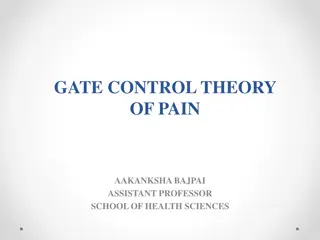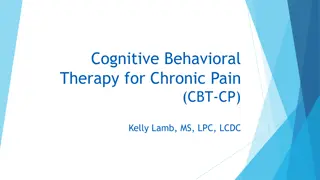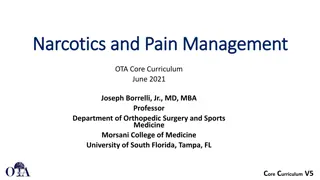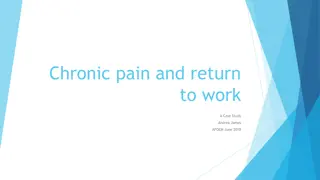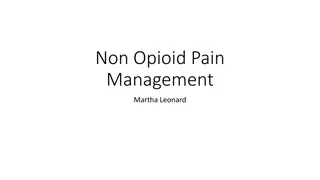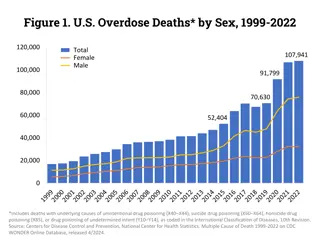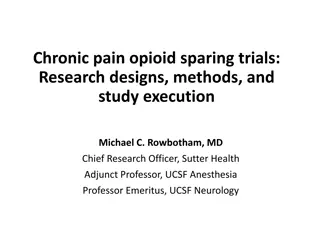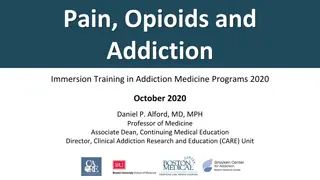Knowing When and How to Taper Opioids for Chronic Pain
This content delves into guidelines and strategies for tapering opioids in chronic pain management, emphasizing the importance of patient education, collaboration with healthcare teams, and developing exit strategies. It also highlights the Colorado DORA guidelines, emphasizing the need for assessing patient functionality regularly and re-balancing risks and benefits of opioid therapy. Various disease-specific patient-reported measures of function are discussed, along with general measures of function in chronic pain. Overall, it provides valuable insights for prescribers and healthcare professionals.
Download Presentation

Please find below an Image/Link to download the presentation.
The content on the website is provided AS IS for your information and personal use only. It may not be sold, licensed, or shared on other websites without obtaining consent from the author.If you encounter any issues during the download, it is possible that the publisher has removed the file from their server.
You are allowed to download the files provided on this website for personal or commercial use, subject to the condition that they are used lawfully. All files are the property of their respective owners.
The content on the website is provided AS IS for your information and personal use only. It may not be sold, licensed, or shared on other websites without obtaining consent from the author.
E N D
Presentation Transcript
Are you doing better? Knowing when and how to taper opioids for chronic pain Rachael Rzasa Lynn, MD Shared Learning Call 22 9 22
Colorado DORA Guidelines (3/2019) Prior to prescribing opioids: Develop and Maintain Competence Diagnose and Evaluate Patient Consider Alternatives to Opioids Collaborate with the Healthcare Team Patient Education Develop an Exit Strategy This Photo by Unknown Author is licensed under CC BY-NC
DORA: Exit Strategy Prior to initiating opioid therapy, prescribers should develop a longitudinal treatment plan for the management of the patient s pain. This plan should be established with the patient, particularly as it relates to how treatment effectiveness will be established and setting realistic goals for pain and function. Highlight how and when opioid therapy will be discontinued, linking the discontinuation of the therapy to the achievement of functional goals. Ensure the patient is aware that opioid therapy should be discontinued, absent clinically significant improvement in pain and function or when the risks of opioid therapy outweigh the benefits.
Colorado DORA Guidelines (3/2019) Assessment of patient functionality early and often. Frequently re-balance the risks and benefits of continued opioid therapy.
Area/disease specific patient reported measures of function Back pain: Oswestry Disability Index Roland-Morris Disability Questionnaire (24 questions, because of my back ) Neck pain: Neck Disability Index Joint pain: WOMAC Pain severity during various positions or movements 5 items The severity of joint stiffness 2 items Difficulty performing daily functional activities 17 items Headache: MIDAS (disability), HIT-6 (6 questions re: social functioning, role functioning, vitality, cognitive functioning and psychological distress)
General Measures of Function in Chronic Pain https://www.aafp.org/dam/AAFP/documents/patient_care/pain_management/cpm-toolkit-pain-assessment.pdf)
General patient reported measures of function PROMIS Pain Interference Short Form 8a Vs Short Form 4a
Individualized Functional Goals Modified Patient Specific Functional Scale Identify up to three important activities that you are unable to do or are having difficulty with as a result of your _________________ problem. Today, are there any activities that you are unable to do or having difficulty with because of your _________________ problem? Stratford, P., Gill, C., Westaway, M., & Binkley, J. (1995). Assessing disability and change on individual patients: a report of a patient specific measure. Physiotherapy Canada, 47, 258-263.
DORA: Exit Strategy Prior to initiating opioid therapy, prescribers should develop a longitudinal treatment plan for the management of the patient s pain. This plan should be established with the patient, particularly as it relates to how treatment effectiveness will be established and setting realistic goals for pain and function. Highlight how and when opioid therapy will be discontinued, linking the discontinuation of the therapy to the achievement of functional goals. Ensure the patient is aware that opioid therapy should be discontinued, absent clinically significant improvement in pain and function or when the risks of opioid therapy outweigh the benefits.
Consider discontinuing opioids when: The underlying painful condition is resolved; Intolerable side effects emerge; The analgesic effect is inadequate; The patient s quality of life fails to improve; Functioning fails to improve or deteriorates; The risks of treatment outweigh the benefits; The patient overdoses; The patient demonstrates suicidality; Non-compliance with the treatment plan; The prescriber suspects diversion; or The prescriber suspects opioid misuse or abuse. Discontinue vs Escalate?
CDC Recommendations for Opioid Escalation Avoid Titrating Opioids to 90 MME/Day Any increase should be the smallest practical amount and should be done in coordination with other pain therapies. Continually monitor benefits and risks associated with the increase. Patients should be aware of the indications for tapering. Reevaluate benefits and harms with patients within 1 to 4 weeks of starting opioid therapy or a dose escalation. Patients who do not have pain relief with opioids at 1 month are unlikely to experience pain relief with opioids at 6 months.
Dose Escalation Observational Data Henry et al (2015): 246 patients starting opioids (na ve) for MSK pain who continued opioids for 1 year Twenty-three (9%) of experienced dose escalation (defined as an increase in mean daily opioid dose of 30-mg morphine equivalents over 1 year). Compared with patients without dose escalation, patients with escalation had higher rates of substance use diagnoses (17% vs 1%, P = 0.01) and more total outpatient encounters (51 vs 35, P = 0.002) over 1 year.
Retrospective Cohort Opioid dose escalators (>20% increase in average MME daily dose) compared with dose maintainers ( 20% change) 32,420 dose maintainers and 20,767 dose escalators, with 19,358 (93%) matched pairs Pain on NRS assessed over 2 consecutive 6-month periods Pain scores were persistently higher among dose escalators at each 90-day period after the index date but not different in the 90 days before the index date Opioid dose escalation not associated with improvements in NRS pain scores. Pain. , 2020, Vol.161(5), p.979-988
When to taper (CDC, BRAVO, HHS, VA) The patient has no sustained clinically meaningful improvement in pain and function. The medication fails to show significant analgesia despite incremental dose increases. The patient is taking opioid dosages >=50 MME/day without evidence of benefit. MED is in excess of 90 mg/d (methadone dose > 30mg/d) The patient is on concurrent benzodiazepines that cannot be tapered. The patient requests dosage reduction or discontinuation. The patient experiences overdose, other serious adverse events, and/or warning signs of such events. Side effects of medication are interfering with quality of life. Significant physical risk factors are present (sleep apnea, prolonged QT, pulmonary disease, etc.). The patient has current evidence of opioid misuse
When to taper (HHS) Cautionary dosage thresholds are NOT mandates for dose reduction. CDC Guideline recommends avoiding or carefully justifying increasing dosages above 90 MME/day, but does not recommend abruptly reducing opioids from higher dosages. Consider individual patient situations. Discuss with patients their perceptions of risks, benefits, and adverse effects. Include patient concerns in taper planning. If the current opioid regimen does not put the patient at imminent risk, tapering does not need to occur immediately. Take time to obtain patient buy-in. Collaborate with the patient on a tapering plan. Tapering is more likely to be successful when patients collaborate in the taper. Include patients in decisions, such as which medication will be decreased first and how quickly tapering will occur. Individualize the taper rate
6BB Opioid Tapering Tools BRAVO Protocol VA Opioid Decision Tool HHS Guide for Clinicians on the Appropriate Dosage Reduction or Discontinuation of Long-Term Opioid Analgesics
How to Taper: BRAVO Broaching the topic Risk-Benefit Addiction Happens V = Velocity Matters (And So Does Validation) The biggest mistake providers make in tapering patients off chronic opioid therapy is going too fast. Decreasing by 5% to 10% of the starting dose every 1 to 2 weeks is intolerable for some patients, especially those on high doses long term. May need to decrease by as little as 5% or less every 2 to 3 months, with even smaller decrements toward the end of the taper.
BRAVO Broaching the topic Risk-Benefit Addiction Happens V = Velocity Matters (And So Does Validation) The biggest mistake providers make in tapering patients off chronic opioid therapy is going too fast. Keep the same dosing schedule If multiple opioids/formulations, let the patient decide which medication to taper first unless there is an immediate safety issue It s okay to take breaks in the taper, but Never go backward during the taper (i.e., increase the dose)
BRAVO V = Velocity Matters my #1 mistake providers make KEEP THE SAME DOSING SCHEDULE decrease the dose, NOT the frequency
Opioid Withdrawal With chronic use, development of tolerance, opioid likely no longer treating pain but merely treating withdrawal from the last dose. Pain during opioid downward titration is NOT an indication of opioid analgesic efficacy nor progression of their underlying pain condition
BRAVO: Other Strategies Consider adjuvants: Antidepressants to manage irritability, sleep disturbance (e.g., trazodone) Hydroxyzine for insomnia and anxiety Anti-epileptics for neuropathic pain Clonidine for autonomic withdrawal symptoms such as rhinorrhea, diarrhea, sweating, tachycardia, hypertension NSAIDS for myalgia (e.g., ibuprofen) Anti-diarrheal agents for diarrhea Offer non-opioid pain therapies during the taper Help patients practice mindfulness to re-orient toward their pain Teach opposite action skills, and remind patients hurt doesn t always equal harm. opposite action skills: acting opposite to the emotional urge in the service of pursing values or goals. Many patients with chronic pain become obsessively focused on their pain and let it limit their participation in many activities. By contrast, providers can encourage patients to do the opposite and engage in activities, within reason, despite pain being present.
https://familymedicine.uw.edu/improvingopioidcare/wp-content/uploads/sites/9/2018/02/VA-Opioid-Taper-Decision-Tool.pdfhttps://familymedicine.uw.edu/improvingopioidcare/wp-content/uploads/sites/9/2018/02/VA-Opioid-Taper-Decision-Tool.pdf
Slowest taper: 2-10% every 4-8 weeks Month 8: 45mg+45mg+60mg= 150mg Month 9: 45mg TID = 15mg reduction = 10% Month 10: ??? Long-acting opioid formulations typically do not have ability to adjust in very small increments May need to temporarily add or increase short-acting opioid to offset a large jump due to formulation limitations reduce/eliminate prior to next reduction in long-acting
Follow-up during taper https://familymedicine.uw.edu/improvingopioidcare/wp-content/uploads/sites/9/2018/02/VA-Opioid-Taper-Decision-Tool.pdf








